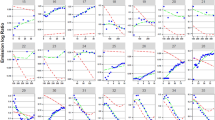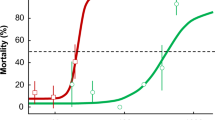Abstract
SINCE 1958, when the occurrence of DDT and its metabolites in the tissues of earthworms was first reported, there have been more than twenty other reports of DDT residues being found in these animals1,2. The amounts found have differed greatly, ranging from minute traces to concentrations of nearly 700 p.p.m., although concentrations of the order of 1 to 10 p.p.m. have been more commonly reported. Sometimes the concentrations of DDT residues found in the earthworms have been less than in the soil where they live, although the tissues of the worms have usually contained greater concentrations than the surrounding soil. When all the published data were considered, it was seen that there is a linear correlation between the concentration of DDT (and other organochlorine insecticides) in earthworms and that in the corresponding soil1. Not all species concentrate insecticides in the same way or to the same degree3; Lumbricus terrestris and other species with permanent burrows take up DDT from the soil surface more readily than from residues that have been thoroughly mixed into the upper strata of soil. Conversely, some of the species without permanent burrows, that tunnel haphazardly through the upper 150 mm of soil, take up more residues from insecticides evenly distributed through the upper soil layers to plough depth.
This is a preview of subscription content, access via your institution
Access options
Subscribe to this journal
Receive 51 print issues and online access
$199.00 per year
only $3.90 per issue
Buy this article
- Purchase on Springer Link
- Instant access to full article PDF
Prices may be subject to local taxes which are calculated during checkout
Similar content being viewed by others
References
Edwards, C. A., Persistent Pesticides in the Environment (Chemical Rubber Company Press, 1970).
Edwards, C. A., and Thompson, A. R., Residue Reviews, 45, (1973).
Wheatley, G. A., and Hardman, J. A., J. Sci. Fd Agric., 19, 219 (1968).
Dindal, D. L., and Wurzingor, K. H., Bull. environ. Contam. Toxicol., 6, 362 (1971).
Eberhardt, L. L., Meeks, R. L., and Peterle, T. J., A.E.C. Res. Dev. Rep. B.N.W.L.–1297, 61 (1970).
Barker, R. J., J. Wildl. Mgmt, 22 (3), 269 (1958).
Davis, B. N. K., Ann. appl. Biol., 61, 29 (1968).
Dimond, J. B., Belyea, G. Y., Kadunce, R. E, Getchell, S. A., and Blease, J. A., Can. Ent., 102, 1122 (1970).
McLane, M. A. R., Stickel, L. F., and Newsan, J. D., Pestic. Mon. J., 3, 248 (1971).
Gish, C. D., Pestic. Mon. J., 3 (4), 241 (1970).
Author information
Authors and Affiliations
Rights and permissions
About this article
Cite this article
EDWARDS, C., JEFFS, K. Rate of Uptake of DDT from Soil by Earthworms. Nature 247, 157–158 (1974). https://doi.org/10.1038/247157a0
Received:
Issue Date:
DOI: https://doi.org/10.1038/247157a0
This article is cited by
-
Toxic effects of two organophosphate insecticides, monocrotophos and dichlorvos to common earthworm Lampito Mauritii (Kinberg)
Water, Air, and Soil Pollution (1986)
-
Pesticidal effects of SevinR (1-naphthyl-n-methyl carbamate) on the survivability and abundance of earthwormPontoscolex corethrurus
Proceedings: Animal Sciences (1979)
-
Metabolism of14C-DDT inPheretima posthuma and effect of pretreatment with DDT, lindane and dieldrin
Bulletin of Environmental Contamination and Toxicology (1978)
-
Gehalt an Umweltchemikalien (Organochlorverbindungen) in Amselelern aus charakteristischen Biotopen
Anzeiger für Schädlingskunde Pflanzenschutz Umweltschutz (1978)
-
Metabolism of14C-DDT inPheretima posthuma and effect of pretreatment with DDT, lindane and dieldrin
Bulletin of Environmental Contamination and Toxicology (1978)
Comments
By submitting a comment you agree to abide by our Terms and Community Guidelines. If you find something abusive or that does not comply with our terms or guidelines please flag it as inappropriate.



